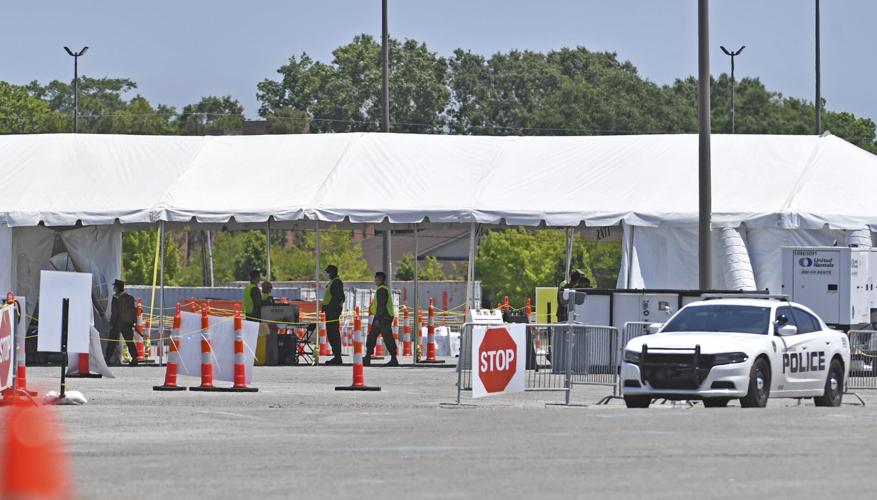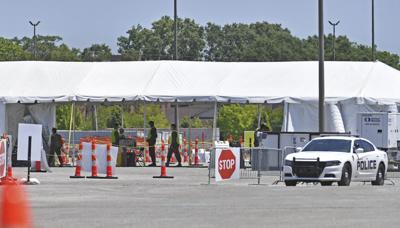When Louisiana began its coronavirus vaccine rollout in December, state officials and hospital leaders moved fast to get shots into arms.
In the early weeks, Louisiana kept pace — and at times beat — the national average when it came to percentage of the state's population that had received a vaccine. At one point, in late January, Louisiana was ranked as high as 14th for the percentage of people it had inoculated.
In recent weeks, though, Louisiana has tumbled to the back of the pack. Just 31% of the state's residents have gotten at least one shot, ahead of only Mississippi and Alabama. Outside of Orleans and West Feliciana parishes, where 42.4% and 53.5% of residents have gotten a vaccine, the rest of the state is well below the national average of 41%.
A million doses, representing one out every four sent to Louisiana by the federal government, are sitting on shelves. A federal vaccine site set in Baton Rouge with the capacity to give out 3,000 shots per day has been averaging just 100 per day since April 16, Gov. John Bel Edwards said Thursday. The state's rate of vaccinations has fallen to a level last seen in January, when few people qualified for a shot and there was little supply available.

New vaccinations in sharp decline: The number of people getting their first COVID vaccine dose fell to 45,086 over the past week, the lowest number since the vaccination effort ramped up in January.
Louisiana sits near the bottom of many state health and well-being rankings. And while public-health experts said Louisiana faces some inherent disadvantages to in the race to get people vaccinated, they pointed to several examples of other relatively poor, relatively rural states that have managed to keep pace with states in richer, more densely-populated regions.
Jennifer Kates, a health-policy analyst with the Kaiser Family Foundation, a nonprofit research and advocacy organization, has been tracking vaccination rates and state plans. She said that there are already some successful practices that are emerging from the first months of the rollout, but they've varied widely across the U.S.
"States have done very different things," said Kates. "Some states have had a really successful vaccination campaign, and others, like Louisiana, are really towards the bottom."
The top three states when it comes to the percentage of their residents that have been vaccinated are New Hampshire, Connecticut and Massachusetts, with all of them reaching more than 51% of their populations. But states like New Mexico, Hawaii, Alaska and South Dakota aren't far behind.
A week after federal regulators recommended pausing distribution of the Johnson & Johnson COVID-19 vaccine, local public health experts ar…
States with the most success share a few common factors, Kates said. Many of them have small populations even if they are large geographically, and are using innovative approaches to reach every corner of the state.
In Alaska, where 41% of the mostly rural population has received a vaccine, providers used toboggans and sea planes to reach remote areas.
The same was true in far-away parts of Indian Country, according to Kailee Fretland, a pharmacist at the Red Lake Nation in Minnesota who has overseen the Indian Health Service’s COVID-19 task force.
“They flew helicopters down to the base of the Grand Canyon to get to one of the tribes,” said Fretland.
With a hub-and-spoke model that first prioritized small pharmacies over mass vaccination sites, Louisiana also attempted to reach rural areas and less-populated parishes. But some experts said Louisiana's demographics might have worked against those efforts, based on studies and surveys of groups and their willingness to get a COVID shot.
“One of the large demographic groups that seem to have more hesitancy than other groups seem to be rural and White, and Louisiana does have a substantial population of that compared to other states,” said Charles Stoecker, a health economist who studies vaccine policy at Tulane University.
Republicans are another group that has expressed hesitancy, according to a poll conducted between Jan. and March by LSU's Public Policy Research Lab. Around 40% of Republicans in Louisiana said they don't plan on getting vaccinated against COVID-19, compared to 13% of Democrats. Around 58% of the state voted Republican in the last presidential election.
More than 40% of Republicans in Louisiana said they don't plan on getting vaccinated against COVID-19, revealing a starkly partisan divide whe…
Louisiana also has a large share of Black residents, at 30% compared to a national average of less than half that. A February poll from the Louisiana Public Health Institute showed that Black people under 60 are also less enthusiastic about the vaccine than White people, with 55% of Black people reporting they are unwilling or hesitant to get a vaccine compared to 37% of White people.
Still, other states have populations with long-standing reasons for distrust of the government, too. In New Mexico, which has a vaccination rate of 49%, American Indians make up 10% of the population. Officials experienced pushback on vaccines at first. And there were challenges: many don’t have transportation, cell phones or reliable internet access.
“The Native Americans here in Jemez, they have a lot of elders and some of the members are really traditional,” said Michael Chinana, 1st Lieutenant Governor of the Pueblo of Jemez, one of New Mexico's 23 Indian tribes. “They were kind of against getting a vaccine in the beginning.”
But four months after the first doses arrived, at least 77% of the 3,600-person sovereign nation, located about 50 miles northwest of Albuquerque, has been vaccinated. The Pueblo of Jemez Medical Clinic mounted an education campaign that included answering questions, sending out flyers and weekly meetings with community members.
“As medical people, we can say, ‘Oh, you should do this,’ and 'Let’s give you information,' but it was really discussions with tribal leadership,” said Dr. Emily Rothman, medical director of the Jemez Health & Human Services, the tribally-controlled health department. “The whole team is vital.”
Communities with high acceptance rates in Alaska, South Dakota and New Mexico, all of which have a significant tribal presence, leaned on cultural principles that value the collective society.
“You're not vaccinating for the individual, you're vaccinating for family and community,” said Rothman. “They're doing it to help each other.”
LSU's School of Dentistry backtracked on mandating COVID-19 vaccinations for students, faculty and staff who interact with patients after some…
Fretland noted that every community has the equivalent of tribal elders, and public-health officials need to use them as allies.
“We have church leaders, community leaders, leaders in our workplace that can be supportive,” said Fretland. “Each of us as individuals can be that person.”
Louisiana officials have enlisted faith organizations and held pop-up events. Julia Letlow, who replaced her late husband Luke Letlow in the House of Representatives for Louisiana's 5th congressional district after he died from COVID-19 in December, urged vaccination on national television.
But a survey conducted by The Advocate ahead of this year's legislative session found that 30 Louisiana lawmakers — 26 of them Republicans — had yet to get the vaccine. An additional 14 GOP representatives refused to answer the survey.
Some were outspoken against the vaccine. Others cited privacy concerns when choosing not to answer.
"I don't want my constituents to be influenced one way or another by my decision,” said Rep. Jonathan Goudeau, R-Lafayette, who declined to answer whether he had been vaccinated.
Dr. Lauren Davis, an internal medicine physician at LSU Health New Orleans, hears a little bit of everything from patients when she asked about their vaccine hesitancy. There are those who won’t get the vaccine, ever, but mostly people have questions. Some of them repeat myths and rumors found on social media. Younger people are the most hesitant, she said.
“Anyone who is a leader among young people ... someone from the Saints speaking out about why vaccines are important, that would be impactful,” said Davis.
State and local leaders have taken some steps that experts say may help. In New Orleans, one of the places leading the state in vaccinations, a street team has knocked on doors with flyers, EMS has delivered vaccines to homebound patients and the health department has created a central registry and encouraged vaccine events at bars and restaurants.
The Louisiana Department of Health has acknowledged that the vaccine effort has become more difficult. They created an information and appointment hotline and sent over 100,000 pieces of mail about new events targeted at the state's most hesitant. A grassroots team knocked on nearly 3,000 doors, gave out 5,000 flyers and sent over 17,000 text messages.
Dr. Joe Kanter, the state's health officer, said the U.S. as a whole was entering "a more challenging phase" that would be more work.
"It's going to be more deliberate," said Kanter at a Thursday press conference. "We need to be reaching individuals to engage in conversation, get questions answered and help people get connected to vaccine events."
Kates acknowledged that Louisiana has had a tougher time keeping up with vaccination rates for the same deeply rooted reasons some areas were so hard-hit in the early days of coronavirus.
“The states in the South have tended to have socioeconomic variables, lower education, higher poverty, more unemployment, more uninsured people,” said Kates.
President Joe Biden this week celebrated reaching his goal of reaching 200 million shots in the first 100 days of his administration, but demand is dropping off in other states in addition to Louisiana.
Still, the slump in Louisiana suggests the state has a long way to go to reach herd immunity. Last week, Louisiana declined some of its allotted doses from the federal government.
During the all-time high of vaccinations, the state gave out 168,353 new first shots. Last week, it was a quarter of that.
Staff writers Jeff Adelson and Blake Paterson contributed to this report.












